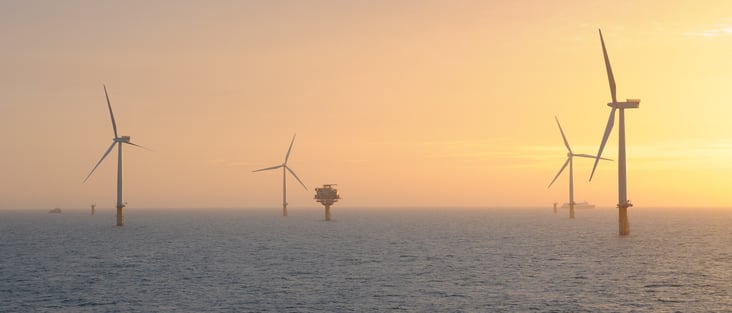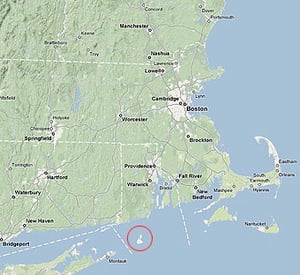
High winds over ocean waves off the U.S. coast are a literal perfect storm of untapped potential for energy generation. Europe has taken advantage of this since 1991… before the fall of the Soviet Union. Here in the U.S., offshore wind has not yet become a reality. But that’s about to change. Hold onto your hats!
This summer, off the coast of Rhode Island, Deepwater Wind “broke water” near Block Island. In July, the company delivered the foundations that will eventually support five wind turbines about 12 miles from the Rhode Island coast. The steel foundations are supplied by a company that usually builds infrastructure for the oil and gas industry on the Gulf Coast.
“It’s a proverbial steel-in-the-water moment,” Jeffrey Grybowski, CEO of Deepwater Wind said in July.
This week, Slate Magazine ran a profile on the project, titled “Meet America’s First Offshore Wind Farm.” It itemizes the menu that let the Block Island farm cut through the red tape and opposition that have stymied other projects: location, location, location, and a side of island economics.
The Block Island Tourism Council’s website claims that “getting here is half the adventure of the vacation.” Visitors take a private boat, plane, or a ferry across 15 miles of ocean from Point Judith, the southern-most tip of Rhode Island. The Deepwater Wind project is three miles southeast of the island, which, as Slate points out, is “effectively in the middle of the Atlantic Ocean.” Plus, the state of Rhode Island chose the spot themselves, not the developer, which “greatly reduced opposition to the project,” says Grybowski.
 Block Island, courtesy of the Block Island Tourism Council.
Block Island, courtesy of the Block Island Tourism Council.
As for the economics, well, it’s an island, with no connection to the onshore power grid. Like Hawaii, which sees the highest electricity prices in the country, electricity on Block Island is expensive. During peak summer hours, Block Island Power Co. charges as much as $0.24 per kilowatt-hour. In July 2014, the average price per kilowatt-hour in Rhode Island overall was under $0.17.
As Slate points out, the wind farm will replace old diesel generators and offer electricity at about the same price, in addition to building transmission that will connect the island to the mainland grid for the first time. It’s a win-win-win for offshore wind and for residents.
Elsewhere in the U.S., offshore wind continues its stuttering way toward adoption. Last month the New Jersey Supreme Court allowed a ruling to stand that “effectively blocks” construction of a pilot facility, despite incentives long in place but never approved by regulators. The state Board of Public Utilities has denied the proposal “multiple times,” citing risks associated with the project’s financing and the possible cost to ratepayers. Fishermen’s Energy, the company behind the pilot project, now says it will revise plans for the facility to better address the BPU’s concerns. One switch: subbing in turbines from AEE member Siemens.
Meanwhile, in Massachusetts, Cape Wind, which is both the first American offshore wind developer and the one that has faced the most opposition, is down but, according to the developer, not out. Despite a huge setback in January when utilities National Grid and Northeast Utilities pulled out of their contracts because Cape Wind failed to close financing for construction by the end of 2014, Jim Gordon, president of Cape Wind, hasn’t given up.
Massachusetts is developing legislation that would have utilities enter into more long-term contracts for the development of renewable energy, and some lawmakers from the New Bedford area (home of a new terminal built to support offshore wind development) are pushing to include offshore wind in the deals. Between that, the announcement that the Pilgrim Station nuclear plant will close in 2019, and ongoing concern about natural gas supplies, Gordon sees a way forward for Cape Wind. “We think we’ve got a terrific project in a great location,” he said.
In addition to these in the Northeast, projects are being developed in Virginia and Hawaii as well. Europe, however, still reigns supreme. A Danish company announced this week that it will build an installation off the coast of the United Kingdom that, at 630 MW, will rival a mid-size coal-fired power plant in terms of electricity generated. If all goes well, someday in the near future, the U.S. may even begin to catch up.
Stay up-to-date on all the developments in offshore wind and other exciting advanced energy news with AEE Weekly. Sign up below!
